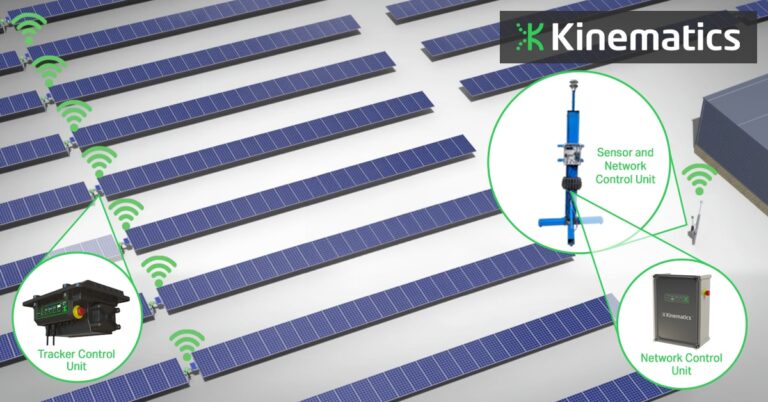By Gautam Ghose | Kinematics
What comes to mind when I say the sentence solar networks?
If your first thought is about exchanging business cards and making small talk during the exhibit hall happy hours, you’re not alone. But there’s a lot more to solar networks than just working deals, especially in the context of large-scale solar.
On a 50 MW project, an asset manager today may have between 1,500 and 2,000 network devices (e.g. tracker controllers, inverters and weather monitoring stations) that protect the plant infrastructure while providing safe and reliable control over the system’s live equipment and moving parts. .
In this article I will talk about the developments in networking and the Internet of Things (IoT), why in-plant networks have become critical for the operation of large-scale solar power plants, and some of the leading options that are available for networks in large-scale solar power plants. .
It’s important to understand how the communications technology you integrate into your next solar project can impact performance and operational efficiency for years to come.
What is power plant networking?
Networking has transformed virtually every aspect of the built environment we use at home, on the road and in the places we visit every day.
By linking technologies like Amazon Alexa, Apple Home and Google Assistant to connected devices in the home, you can now unlock your front door with a tap on your watch. Smart lighting and temperature control systems can detect who is home and what you are doing, seamlessly making the space more comfortable. In the kitchen, you can get recipe suggestions based on what’s in the fridge, notifications so you don’t overcook the meal in the oven, and grocery orders to replenish important items when they’re running low.
In the city, your car can communicate with other vehicles to avoid traffic congestion and connect to smart parking meters to find a curbside spot near your destination. Across the community, public services can operate more efficiently as waste management systems monitor bin usage to reduce unnecessary collections, streetlight sensors adjust brightness to improve public safety or reduce energy costs, and smart grid technologies help consumers optimize energy use.
All these systems use the same essential network elements:
- Computer equipment, including network nodes for sending and receiving data
- Communication protocols
- Wired or wireless network connections
- Other system characteristics, such as network topology and geographic scale
Just as some devices work better in home networks than outside of them, the same goes for communications protocols and network topologies. The network features that support smart home functionality will not necessarily be the best choice for orchestrating wind sensors, inverters, and other components in large-scale solar infrastructure, as I discuss below.
Why networking is important for solar energy
As solar energy accounts for an increasing share of electricity production, grid operators are increasingly relying on solar energy for stable, predictable energy. Disruptions in services cannot only cause the bulk energy system to suffer from a shortage of energy supply. They can also make it more difficult to maintain the stability of the electricity grid. Serious financial penalties can result from failure to meet contractual energy supply quotas.
Best-in-class grid systems provide the monitoring and control capabilities for solar power plants to deliver enterprise-level reliability comparable to the transmission and distribution infrastructure and established fleets of large-scale power plants. Weather monitoring system data, combined with structural and electrical performance data, helps build a 360-degree view of solar power plant performance.
Just as municipalities use smart city technology to reduce costs and increase efficiency in waste management, street lighting and public safety, smart utility grids enable solar operators to improve the use of solar energy resources.
Although 50 MW solar power plants have been and continue to be exempt from cybersecurity standards for the largest power plants on the grid, federal regulators have called for smaller projects to voluntarily report their compliance, which is overseen by the North American Electric Reliability Corp. through the Critical Infrastructure Protection Program (NERC CIP). Some industry analysts expect it is only a matter of time before voluntary reporting becomes mandatory.
Factories that lead the adoption of enterprise-level networking can simplify the deployment and operation of IoT devices. Using the latest, most advanced communications protocols, new devices can use self-shaping capabilities to automatically join existing networks and self-healing capabilities to rearrange network paths when a system bottleneck occurs.
Network options for large-scale solar energy
In home automation kits, industrial control systems and other IoT applications, many commercial products use Zigbee communication protocols for wireless networks. The first version of the Zigbee standard was released in 2004, making Zigbee older than the iPhone. Over the past two decades, other notable wireless networking options have emerged, including Wi-SUN in 2012 and LoRaWAN in 2015.
Each technology has enabled the creation of mesh networks with point-to-point data hopping, bypassing the need for a central hub. Solar energy managers should carefully consider purchasing, security and other differentiators before selecting the best available option.
Purchase
Unlike your home, solar power plants require technology that can be supported for 25 years or more, the life of the installation. The ideal architecture is one that is well supported by the industry, offering multiple vendors and active development.
Security
Wireless networks, like any other network, face risks of security threats. Solar power plants are subject to increasing security requirements to ensure that they can be connected safely and reliably to the electricity grid. An internal network that uses and maintains the latest industry standards for encryption and access is the best choice.
Range and interference
Many internal networks operate on the same frequencies as commercial Wi-Fi. This can affect the reliability and performance of factories operating near urban areas. It is essential to consider the network, especially if you are installing in an urban environment.
Performance in complex terrain
Locations can vary significantly in size, terrain and proximity to other networks in use. Networks vary in their ability to support large distances between nodes or work well in hilly terrain. Zigbee uses 2.4 GHz, the same frequency as WiFi. It typically supports a maximum range of 300 meters, subject to interference caused by nearby network usage, and is limited to line of sight. Other standards, such as Wi-SUN, operate at a lower frequency of 900 MHz, have a range of up to 4 kilometers and are more resistant to hilly terrain. Choose the right network type and design to suit the site’s unique size and terrain challenges.
Networks everywhere
The trend lines for wireless networks are clear. The global deployment of IoT connections reached 16.7 billion in 2023, up from 3.6 billion just eight years ago. Solar projects, like many other types of infrastructure, now function more like corporate networks than ever before.
As you evaluate the wireless network options your vendor has chosen, compare systems based on their ability to meet plant needs over the life of the project, their ability to protect against security risks, to operate without interference, and to to deal with terrain challenges.
Most importantly, you work with technology partners who bring the experience and expertise to position your projects for success, from initial design through the entire project lifecycle.
Gautam Ghose is director of solar product line management at Kinematics, where he leads the conception, development and introduction of new products and the optimization of existing products in all solar energy segments. Gautam brings a wealth of experience leading business teams to create products, set prices, develop and implement marketing programs to drive customer acquisition in the solar and semiconductor industries across horizontal and vertical markets. Under his leadership, Kinematics is expanding its commercial and utility solar product portfolio by introducing the Kinematics ONE tracker control solution.
Listen to more in-depth conversations on Solar Builder’s YouTube channel

Our most popular series include:
Power forward! | A collaboration with BayWa re to discuss industrial topics at a higher level.
The buzz | Where we give our 2 cents per kWh in the residential solar market.
The pitch | Discussions with solar manufacturers about their new technology and ideas.
Source link


